The president who amazed America
What happened after 'Death by Lightning'
Elizabeth Jennings was running late for Sunday services on July 16, 1854 when she and a friend tried to board a horse-drawn streetcar on Manhattan’s Third Avenue. Jennings was a 27-year-old teacher at the African Free School and the organist at the First Colored Congregational Church.
The railcar lacked a “Colored Persons Allowed” sign, but Jennings insisted to the conductor that they couldn’t afford to wait for the next car. “Well, you may go in,” he said, “But remember if the passengers raise any objections you shall go out, whether or no, or I’ll put you out.”
As author Scott S. Greenberger recounts, Jennings shot back, “I am a respectable person, born and raised in New York. I don’t know where you were born, but you are a good-for-nothing impudent fellow for insulting decent persons while on their way to church.”
The conductor and driver grabbed her arms and tried to remove Jennings from the car, but she held firm, until a police officer came aboard and ordered her to leave. The railway workers “jammed her bonnet” and “soiled her dress,” according to an article in the Brooklyn Eagle. New York’s black community was outraged, and Jennings’ father hired a law firm to sue the conductor, driver and streetcar company.
The lawyer representing Jennings persuaded an all-white, all-male jury to award her $225 from the Third Avenue Railroad Company, plus 10% tacked on by the judge. Jennings’ lawyer cited a new state law to hold the company, as a common carrier, liable for the negligent or malicious actions of its employees.
A little more than a century before Rosa Parks refused to give up her seat on a segregated bus in Montgomery, Alabama, a black woman had set a precedent for the desegregation of New York’s transit network.
The newly minted lawyer who won the case for Jennings was 24-year-old Chester A. Arthur, described by Greenberger in his book The Unexpected President as “strikingly handsome,” with a “powerful build, a wispy beard, and stylishly long hair.”
Viewers of Death By Lightning, the hit limited series on Netflix, see Chester Arthur in a much different light: decades later, he’s a corpulent, often drunken, corrupt and self-pitying party hack, adorned with muttonchops.
In real life, there was a third act in Chester Arthur’s life story — a presidency that would amaze the nation, and that, while little remembered today, deserves our careful attention.
What happened to the idealism of his youth? A well-respected lawyer, Arthur made a mark during the Civil War as an exceptionally able administrator in charge of providing housing and other logistics for the state’s new Union regiments. New York’s governor, who appointed Arthur as the state’s quartermaster general, noted his “great executive ability and unbending integrity.”
In those years, though, Arthur signed on as a lobbyist for Thomas Murphy, a merchant who had been accused of providing defective hats and caps to Union troops.
As Greenberger noted, “Arthur’s work on behalf of his unscrupulous client blossomed into a personal friendship, and the two men became partners in several real estate speculations.”
Arthur “no longer viewed politics as a struggle over issues or ideals. It was a partisan game and to the victor went the spoils: jobs, power and money.”
The Conkling gang
Soon Arthur became an ally of Senator Roscoe Conkling. The pair worked together seamlessly for years to extort money for the Republican Party machine from importers and from employees of New York’s federal Customs House, where Arthur served as collector. They became well known as profiteers getting rich off the “spoils system,” under which government employees had to kick back a portion of their salaries to Conkling’s ring to protect their jobs.
For all his power, Conkling made plenty of enemies. “As is true of most men who wield their power like a weapon,” wrote author Candice Millard. “Conkling was widely feared, slavishly obeyed, and secretly despised.” Millard’s book Destiny of the Republic was the basis for the Netflix series.
The “exceedingly vain” Conkling “had broad shoulders and a waspishly thin waist, a physique that he kept in trim by pummeling a punching bag hanging from the ceiling of his office,” wrote Millard. “He wore canary-yellow waistcoats, twisted his thick, wavy blond hair into a spit curl in the center of his high forehead, used lavender ink, and recoiled at the slightest touch.”
In the Netflix series, Chester Arthur is mostly a peripheral character, a henchman to Conkling who only becomes central when as a reluctant vice president, he fearfully succeeds a man of integrity, the assassinated President James A. Garfield.
The story of Arthur’s transformation as president is almost as compelling a tale as that of Garfield’s demise. It shows how a man who had shed his youthful ideals came to realize their power and necessity as he neared the end of his life. It was President Chester Arthur who finally ended the “spoils system” and instituted a professional civil service, in a decisive break with his old boss Conkling.
History matters
Why does a streaming series about a forgotten president and his even more obscure assassin who died almost 150 years ago stir so much interest right now.?
Death by Lightning plunges us into the volatile politics of the 1870s and 1880s, the “Gilded Age.”
There was a vast gulf between the rich and poor. Political parties were rife with corruption and extremism. It was a time of contested elections, of political violence, of exploitative tariffs — in other words, a time when public and private life were subject to the kinds of ills we suffer now. Yet the story of the reform-minded President James Garfield and his assassin Charles Guiteau, the classic “disappointed office seeker,” distracts us from today’s news.
The story told in Death by Lightning plays out for the audience as purely a spectator sport. You can watch it knowing that you have no real stake in the ultimate outcome — even though you are likely curious to see what ultimately happens to the assassin Guiteau.
Played by the gifted actor Mathew Macfadyen, Guiteau comes across as a combination of Tom, his role in Succession, and Cousin Greg, also from that series. The opportunism of Tom and Greg also animates Guiteau. But there is an extra quality to Garfield’s assassin. With superb work by the makeup artists, the patchy-bearded Guiteau bears a frightening glassy stare that leads you to suspect he’ll try anything, including shooting the president.
Millard sums up Guiteau perfectly:
At five feet seven inches tall, with narrow shoulders, a small, sharp face, and a threadbare jacket, Charles Guiteau was an unremarkable figure. He had failed at everything he had tried, and he had tried nearly everything, from law to ministry to even a free-love commune. He had been thrown in jail. His wife had left him. His father believed him insane, and his family had tried to have him institutionalized. In his own mind, however, Guiteau was a man of great distinction and promise, and he predicted a glorious future for himself.
Guiteau made a habit of dining at restaurants and staying at boardinghouses where he would skip out when the bill came due. He saw the surprising emergence of Garfield as a presidential candidate in 1880 as a divine signal of his destiny to serve in a high diplomatic role under the new administration.
When his ridiculous ambition for a consular post in Vienna or Paris was foiled by President Garfield and Secretary of State James G. Blaine, Guiteau reasoned that he would fare better under an administration led by Chester Arthur. With little compunction, he shot Garfield at a Washington train station. The president lingered for 11 weeks with a back wound, as doctors failed to locate the bullet lodged in his body.
‘Snivel service reform’
An almost equally villainous character in the drama is Conkling, a fiercely talented speaker and shameless crook who enforced discipline in the U.S. Senate and in New York’s capital, Albany.
For all of Conklin’s misdeeds he must have been great company at the nearest saloon.
For example he referred to the movement for an honest way of filling government jobs as “snivel service reform”, according to Scott Greenberger. Conkling had no love for his party’s president who was elected in 1876 — Rutherford B. Hayes, the governor of Ohio, who dashed Conkling’s own hope of running for the White House. Conkling referred to him in private as “Ruther-fraud B. Hayes” or “His Fraudulency the President.”
There was some truth in that. Hayes’s Republican party stole the 1876 election.
Democrat Samuel Tilden beat Hayes in the popular and electoral votes but fell one vote short of the needed majority in the electoral college. Southern Democrats agreed to let Hayes”win” the disputed election in return for an end to Reconstruction, a deal that paved the way for brutal suppression of black voters in the South and for the Jim Crow system of segregation.
Conkling’s notoriety deepened in 1879 when Senator William Sprague of Rhode Island returned from a trip to find Conkling living in his house. Conkling had long been carrying on an affair with Sprague’s wife Kate. Conkling at first refused to leave, but finally hastened away after Senator Sprague threatened to turn his shotgun on him.
But of all people, it wasn’t an angry husband but Chester Arthur who finally ended Conkling’s career in politics.
When Arthur became president, he faced a distraught nation and unfriendly press corps. During Garfield’s long ordeal, the Chicago Tribune had referred to the possibility of Arthur succeeding him as a “calamity of the utmost magnitude.” Even though Arthur was blameless in Guiteau’s killing of Garfield, people held it against him that the assassin wished for a President Chester Arthur.
As Garfield lay dying in a cottage in New Jersey, Arthur confessed to a friend that he feared taking over. When word came of the president’s death, Arthur said, “I hope—my God, I do hope it is a mistake!” and began to cry.
Once in office, he felt committed to carrying out Garfield’s program of reform. Arthur decided on the personally painful course of refusing Conkling’s request to take back control of the Customs House. Greenberger wrote:
Watching Garfield’s long ordeal, and the suffering of the dying man’s family, had greatly affected Chester Arthur. Secluded in his Lexington Avenue brownstone as the summer dragged on, he contemplated his own history and the place he might occupy in the history of this country. He had been a machine politician for decades but before that he had been something else: the son of a backwoods preacher; the young lawyer who helped integrate New York City streetcars; the Union army quartermaster who served his country honorably while so many others fed from the public trough…
“For the vice presidency I was indebted to Mr. Conkling,” Arthur said, “but for the presidency of the United States, my debt is to the Almighty.”
Today’s threat
President Chester Arthur signed the civil service reform bill in 1883 and established a civil service commission with real authority. Candidates for many government jobs were required to take competitive exams, and jobs had to be filled based on merit. The law banned the firing or demotion of government employees for political reasons and made it illegal to require workers to make political contributions — precisely the kind of abuse Conkling and Arthur had enforced at the Customs House.
Over time, more and more government jobs came under civil service protection. A new class of skilled, professional workers emerged. Political patronage for the top jobs didn’t go away, of course, but Washington was no longer thoroughly dominated by the spoils system that first emerged under President Andrew Jackson.
Today the clock may be turning back. Federal workers are under attack from an administration that sees government as the enemy. Many civil servants have fallen victim either to DOGE or Project 2025.
Many others are nervously watching. This week Government Executive reported that “Draft final regulations from the Office of Personnel Management will cite ‘accountability to the president’ as grounds for stripping tens of thousands of federal employees of their civil service protections.”
Under a new classification called “Schedule Policy/Career,” as many as 50,000 federal workers could lose their safeguard from being fired at will.
Forgotten
Chester Arthur completed one term as president. Suffering from Bright’s disease, a kidney affliction, he died at the age of 57, less than two years after leaving the White House.
“No man ever entered the Presidency so profoundly and widely distrusted as Chester Alan Arthur,” wrote Alexander K. McClure, editor of the Philadelphia Times, “and no one ever retired from the highest civil trust of the world more generally respected, alike by political friend and foe.”
There’s a statue of Arthur in New York’s Madison Square Park. The brownstone at 123 Lexington Avenue where he took the oath of office as president, and where he died, is partly occupied by Kalustyan’s, a well-stocked specialty food and spice shop.
Tucked away in a corner of the facade is a plaque noting Arthur’s residence in the building and his signing of the Civil Service Act.
Hardly anyone remembers Chester Arthur today. But we should.







